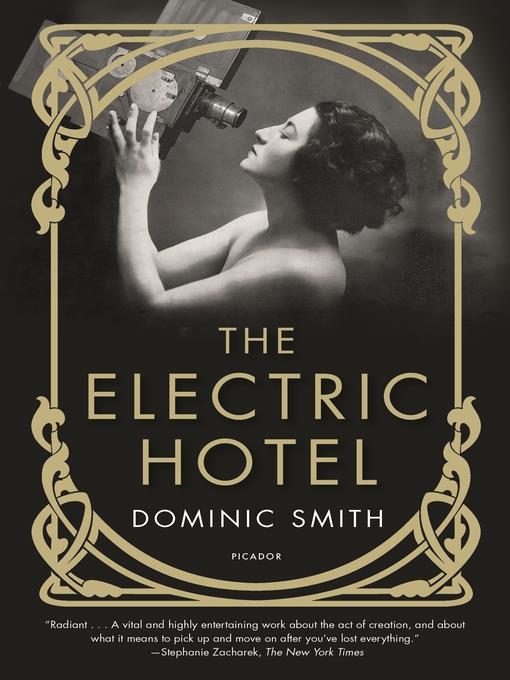
The Electric Hotel
A Novel
کتاب های مرتبط
- اطلاعات
- نقد و بررسی
- دیدگاه کاربران
نقد و بررسی

Following the New York Times best-selling The Last Painting of Sara de Vos, Smith imagines silent-film pioneer Claude Ballard, who began his career as a concession agent for the Lumière brothers and was eventually bankrupted by his chef d'oeuvre, The Electric Hotel. The past is reawakened when a film student comes to interview Claude in his shabby suite at the Hollywood Knickerbocker Hotel.
Copyright 1 Library Journal, LLC Used with permission.
March 15, 2019
A long-retired moviemaker recalls the early days of silent films in Smith's atmospheric follow-up to The Last Painting of Sara De Vos (2016, etc.).In 1962, 85-year-old Claude Ballard lives in a run-down Hollywood hotel and spends his days gathering mushrooms and photographing street scenes. He has not made a movie since his "grand cinematic experiment," The Electric Hotel, appeared in 1910. As his reminiscences to young film scholar Martin Embry unfold, we eventually learn the reasons for his decision, but first we get a wonderfully vivid re-creation of the spell cast by the earliest films, when photographer's apprentice Claude sees the Lumière brothers' first reels exhibited in the basement of a Paris hotel in 1895: "every inch of the screen was alive...you burrowed into the screen, dug it out with your gaze." His work for the Lumières takes him to New York, where the audience's loud response to a moving picture next door to her theater infuriates touring French actress Sabine Montrose. She winds up in bed with Claude and in the new medium; buccaneering producer Hal Bender finds them a studio perched over the Palisades in New Jersey, where he hopes to elude Thomas Edison's litigious Motion Picture Patents Company. Smith skillfully blends film history with the adventures of his cast; a Stanislavsky-obsessed acting coach and an Australian stuntman are among the intriguingly idiosyncratic folks who join Sabine, Claude, and Hal, each haunted by damage a parent has inflicted, to joyously invent a new art form. The novel climaxes with a brilliantly detailed account of the filming of The Electric Hotel and its triumphant premiere, followed by multiple blows that have been deftly foreshadowed. The account of Claude's traumatic experiences filming the devastation of World War I is something of a letdown, but a final scene with Sabine ties up emotional loose ends, and Martin's screening of the restored Electric Hotel provides a moving finale.A compelling plot, robust characters, and finely crafted prose richly evoke a bygone age and art.
COPYRIGHT(2019) Kirkus Reviews, ALL RIGHTS RESERVED.

April 8, 2019
Smith (The Last Painting of Sara De Vos) takes readers back to the dawn of the motion picture era in his splendid latest. Claude Ballard is an old man in 1962, living at Hollywood’s Knickerbocker Hotel, when he’s contacted by Martin Embry, a PhD candidate in film history. When the elderly director reveals that he owns a print of his first feature film, long considered lost, the young scholar’s enthusiasm about its discovery prompts Claude to reminisce about the film’s genesis and aftermath. From his early days photographically documenting ailments at a Paris hospital, to his rapid rise to prominence by demonstrating the capabilities of the Lumière brothers’ moving picture innovations, to his ill-fated (both professionally and personally) production of The Electric Hotel, to his surprising heroic turn in WWI, Claude’s own story—and those of the leading lady, stuntman, and impresario who collaborated with him—unfolds as cinematically as the scenes he creates on film. Fascinating information about the making of silent films (including a villainous cameo by Thomas Edison) is balanced by poignant, emotional portrayals of individuals attempting to define their lives offscreen even as they made history on it. Smith winningly delves into Hollywood’s past.

Starred review from April 1, 2019
In 1962, cinematographer Claude Ballard is rusticating with the other eccentric, washed-up denizens of Hollywood's Knickerbocker Hotel. When a doctoral candidate arrives to interview him, Claude's past begins to unspool, and Smith (The Last Painting of Sara de Vos, 2016) shifts the focus to the nascent film industry at the turn of the century. On the Hudson Palisades, a ragtag bunch of innovators?Claude, aging French stage actress Sabine Montrose (clearly modeled on Sarah Bernhardt), an Australian stunt man, and a Brooklyn entrepreneur?creates a silent film masterpiece, The Electric Hotel. Success is within their grasp when archvillain Thomas Edison lets loose his copyright lawyers. The atmosphere is convincing as Smith transports readers to fin de si�cle New Jersey, the sick room of a tubercular widow, and Belgium in the throes of WWI. The depth and breadth of the characterization is truly impressive, the story line immersive, and the prose richly evocative as the novel ranges from tragic to nail-biting to hilarious. Smith's tale is as luminous as celluloid projected on a silver screen hung from a dirigible floating over the Hudson (yes, this happens). Highly recommended.(Reprinted with permission of Booklist, copyright 2019, American Library Association.)

























دیدگاه کاربران